Premium
Creating exciting Kenyan recipes in top hotels
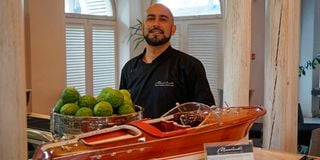
Carlos Espindola, the head chef and executive chef at Mawimbi Seafood Restaurant and Cafe.
Dining experiences in Kenya, especially in top restaurants, have become more westernised over the years with foreign dishes dominating the menus.
The fear of eating something new that may cause a stomach upset or buyer’s remourse, that you wasted your money on a meal that you did not enjoy, prompts some Kenyans to revert to tried and tested food choices on the menu when they choose to eat out.
But many top restaurants are increasingly seeing the value of enhancing their menus with more local foods or spicing up foreign dishes with home-grown recipes. This trend was further influenced by the Covid-19 pandemic that saw the country go into lockdown for most of 2020, completely bringing international travel to a halt and leaving restaurateurs seeking to attract more Kenyan customers.
For example, at the height of the pandemic, the Tribe Hotel in Nairobi was forced to shut down its facilities, including Jiko, its in-house restaurant, for more than a year. It is during this period that Chef Mohammed Ali, Jiko’s current executive chef, embarked on a year-long journey to create a unique menu that is majorly Kenyan.
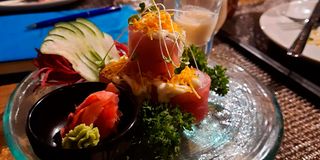
The Bengal roll is a speciality of Chef Carlos Espindola of Mawimbi Seafood, made with sweet potato and raw yellowfin tuna.
Mohamed’s 20-year-long journey in culinary arts started when he was a young boy living in Nairobi.
He says the biggest challenge when he was experimenting was how to make the ingredients blend together for a tasty meal.
“At first, it was hard to convince people to come try out our food when we re-opened on Valentine’s Day this year . We had to be patient enough for clients to accept what we were offering,” he told Lifestyle.
Only nine months later, Jiko is now ranked one of the best Kenyan restaurants by Tripadvisor— an influential online global travel company — with a 5.0 rating and over 635 reviews.
Chef Moha, as he is commonly known, says that it is very hard to find chefs and culinary experts in Kenya experimenting with new, interesting recipes since they prefer to play it safe. He gives the example of how chefs in different countries continue introducing new recipes to common dishes like pasta and pizza for their customers, something not often done in Kenya.
He hopes to put Kenya’s cuisine on the global map with his advanced creations that can be internationally recognised and accepted as he makes a name for himself in his first year and first time as an executive chef in a five-star hotel.
“So far, it is working well. You will find foreigners walk into the restaurant and order one of the meals that has ugali. For local customers, it is a h ard sell telling a Kenyan to come and eat ugali and kales, which they can make at home. That is why we had to make it more interesting through creations such as the kondoo mchuzi, which is ugali, sukuma and lamb stew baked in a puff pastry,” he said.
He also presented crispy deep-fried ugali, which resembles the brown crunchy part of ugali that is left behind in sufurias.
“What we are creating is a new experience for foreigners and memories for Kenyans who have eaten some of these foods regularly,” said the chef.
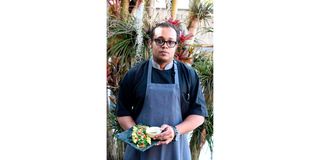
Mohamed Yakat, executive chef, Tribe Hotel displays sukuma wiki salad with barley seeds, raisin, avocado and a maple syrup sauce.
Chef Moha’s expertise is seen in small details such as the chilli and lemon homemade butter served together with bread as people wait for their food.
“Most of the dishes remind me of my childhood. The butter, for instance, was inspired by the chilli and lemon combination used by street vendors on maize on the cob (mahindi choma),” he said.
The chef added, “Unless you go to local eateries and restaurants, you will not get Kenyan dishes at most high-end restaurants. We decided to make an elevated version of local food with some influence from international cuisine. For instance, we wanted to put samosas on the menu but wondered how we could make it more interesting and different. Our most requested samosa is the charcoal brisket which, as its name suggests, is black in colour. We crash active charcoal tablets which help reduce intestinal gas amongst other benefits.”
He puts a twist on several other local dishes such as mutura, where he uses duck meat instead of the usual cow intestines mixed with blood. Chef Moha goes a step further in recipe innovation to make his signature burgers with mandazi instead of the normal sesame buns.
“Mandazi is found everywhere but we could not just sell plain mandazi,” he says.
Apart from Kenyan-based ingredients and produce, he uses additives from all over Africa such as berbere spice from Ethiopia and Rwanda’s secret chilli oil called akabanga.
Chef Carlos Espindola sees Kenya as a second home after relocating in 2019 to become the executive chef of the award-winning outlet, Mawimbi Seafood restaurant located in Nairobi. Born and raised in Ecuador, he found that the food in Kenya was quite similar to that in his home country.
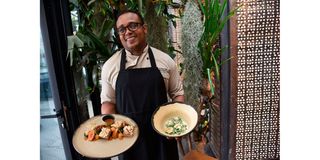
Executive Chef at Jiko restaurant within Tribe hotel Mohamed Yakat displaying Za’atar beef burger on May 31,2022.
“We have our South American kind of ugali made of maize flour, salt, butter and some spices. We call it arepa. We also have kachumbari (fresh tomato and onion salad) which is our traditional salad,” he said.
He explained that Swahili food especially reminds him of South American coastal dishes. He first visited the Kenyan coast when he was doing research about seafood.
“I was surprised to find that the flavours were so alike. They use a lot of garlic, ginger and spices due to Arab influence in most coastal regions of the world. That was many years ago and that intercultural exchange is still felt until today,” he said.
When Chef Carlos first came to Kenya, he started researching about food culture and noticed that seafood was not that common especially in the capital city.
“The most common fish found in Nairobi is tilapia — a lake fish. Sea fish, on the other hand, has more flavour and you can play around with it more. There is great potential for seafood to open the minds and palettes of Kenyans,” said the chef.
He pointed out that sushi has become very popular, a testimony that Kenyans are becoming more open to different tastes due to restaurants such as Hero in Village Market and INTI in Westlands, which offers a Nikkei experience, an infusion of Peruvian ingredients and Japanese cooking techniques.
In their new menu launched last month, Chef Carlos unveiled new additions, including a traditional sushi roll called the bengal. Unlike other sushi rolls, it has sweet potato, a familiar ingredient to most Kenyans, making it recognisable to someone consuming raw, fresh yellowfin tuna for the first time.
He added that raw fish is very healthy contrary to what people believe, and all depends on how well it is handled.
“All of our fish is from local fishermen in Malindi and Kilifi. It is delivered in at least eight hours as seafood tastes much better when it is fresh,” he said.
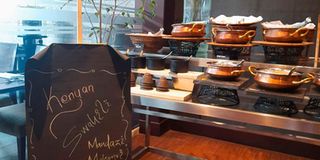
Sankara hotel recently introduced a Kenyan Swahili corner for Kenyans who enjoy their local cuisine and foreigners who wish to try it out.
“It is my strategy to use familiar ingredients such as terere (Amaranth vegetable), Konyagi and kachumbari to make seafood relatable to Kenyans. I also noticed that most Kenyans prefer to consume a lot of super foods such as kales , which is very healthy, available and cheaper than in other countries,” he noted.
One of Mawimbi’s main dishes called the Surf and Turf is made of soft pieces of beef tenderloin, sauteed seasonal prawns in a special sauce, which is a mix of beef and prawn broth and Konyagi, served on a bed of sautéed terere greens. He says it is a fan favourite. They also serve raw, fresh oysters with a dash of kachumbari and lemon.
Mawimbi Seafood Restaurant recently received the Best Leisure Interior Africa Award at the Africa and Arabia Property Awards held in Dubai on October 6. The restaurant also earned the World’s Best Seafood Restaurant award at the World Luxury Restaurant Awards Ceremony last year.
Another five-star hotel, Sankara, has also not been left behind in the new wave. They introduced new additions to their menu, including a Kenyan Swahili corner in their extensive breakfast buffet that was usually mostly made up of European continental dishes such as cereals and pastries.
Sankara Executive Chef Jeff Gitonga said that they established the section in the beginning of October to create a more indulgent experience with a little bit of everything from all over the world, including an Indian and Japanese section.
“In the Kenyan corner, we have a dedicated chef who makes fresh mandazi, mahamri, samosas, bhajia and viazi karai in the morning. The section is an open kitchen so you can watch them make the food while you wait for it to come hot. Fresh, warm, puffy mandazi in the morning always tastes great,” he said.
Chef Jeff says that they have also incorporated local meals such chapati, mukimo, sukuma, ugali, pilau, mbaazi and matoke into their lunch and dinner menus.
“We host several conferences and have a variety of guests from abroad and also Kenya. You would find that most of the Kenyans would ask ‘Where is the ugali or sukuma?’ So we have to ensure that they’re available because they are on demand, even by international guests who would like to try out Kenyan food when staying at the hotel,” he said.
He added that it has expanded their market as more people appreciate how willing and diverse the hotel is with its food varieties.
Kenyan Coffee house, Java, also introduced ugali, chapati and kales side choices to accompany meals. Before this change, all meals were accompanied by either chips, garden salad or fruit salad. Kenyans also briefly saw American multinational food chain Kentucky Fried Chicken (KFC) offer ugali.
To the top restaurants and chefs, spicing up their menus with more local recipes is not only exciting but also makes economic sense.





